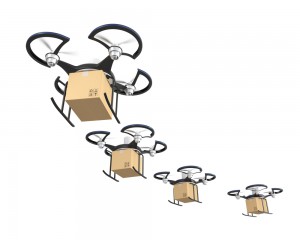Share This
Related Posts
Tags
Drone Deliveries
By Anca Gagiuc on Feb 10, 2016 in Technology
Drones are unstoppable. Within the next on e to three years we’ll receive our orders via drones if the private sector and government work hand in hand.
e to three years we’ll receive our orders via drones if the private sector and government work hand in hand.
Giants like Google and Amazon, and Wal-Mart have all announced working on developing their own fleet of drones to ship orders. The main setback remains the number of regulatory issues which need ironing out first. Currently, businesses interested in flying drones for commercial purposes need to seek approval from the Federal Aviation Administration on a case-by-case basis. Furthermore, under current drone rules, companies aren’t allowed to fly drones at night and drone operators can’t fly more than one drone at a time—well, except for the special show Intel prepared in collaboration with Ars Electronica Futurelab near Hamburg where four drone operators had each 25 drones under their command. You can watch the thing of beauty in the below video.
Earlier this year, FAA Administrator Michael Huerta announced that the government plans to finalize its drone rules for commercial operations by late spring. The FAA enlisted a handful a drone makers, industry advocates, and retailers such as Google to help create the registration system and rules. The respective registration system came online in late December; since then 181,000 drones have been logged in its database.
Google has been exploring the use of drones for deliveries over the past three years. Research continues under Dave Vos, head of Google X’s Project Wing experimental drone delivery program. At an aviation industry event in Washington, he stated that drones will be safer than general aviation and that they’ll operate quietly enough so as to not disturb anyone. According to Vos and his Jetsonian vision, people will eventually be transported from one point to another via autonomous airplanes.
“Moving people and stuff around the planet in an efficient way is where I want to get,” stated Vos.
Amazon can already deliver items to some of their customers in just a few hours after they’ve been ordered. The giant retailer says it can decrease the delivery time to just 30 minutes if it can deliver packages via drones through its Amazon Prime Air service. The service has no certainty when and if will launch, but in an interview with Yahoo, Paul Misener, Amazon’s vice president for global public policy answered a set of questions related to Amazon Prime Air.
Amazon’s drones will weigh about 55 pounds each and will be able to lift packages that weigh up to five pounds. The range has to be over 10 miles. The packages will be delivered to a customer’s doorstep even if they are not home. “It gets delivered to your doorstep, or wherever you want in your yard, just as it would be if it were delivered by the UPS truck,” Misener said to Pogue.
Just like it happened before with at-the-time novelties, drones will become ordinary. According to Misener, Prime Air drones will be as normal as seeing a delivering truck driving down the street. When asked about the level of safety when delivering orders by drone, worried that someone might shoot it down, Misener answered: “I suppose they could shoot at trucks, too.”
Amazon is working on different drone designs to work with any type of environment—from hot, dry, dusty areas like Phoenix to hot, wet, rainy environments like Orlando. Furthermore, the company is taking into consideration the wide variety of buildings—from rural farmhouses, to high-rise city skyscrapers and everything in between. It may be that each type of environment will work best with a different kind of drone.
The company is building highly automated drones with sense-and-avoid technology that makes them see and avoid obstacles.
“These drones are more like horses than cars — and let me explain why. If you have a small tree in your front yard, and you want to bang your car into it for some reason, you can do that. Your spouse might not be happy with you, but you can do it. But try riding a horse into the tree. It won’t do it. The horse will see the tree and go around it. Same way our drones will not run into trees, because they will know not to run into it.”
Anyone who’s been around a drone knows that they are not quiet. Add that to the nearness of a busy street and the noise might become too much to handle. Amazon says that the noise issue is a challenge they’re looking into.
Aside from Google and Amazon, Walmart is interested in drone deliveries as last October it applied to U.S. regulators for permission to test drones for delivery as well. The Jetsons are not too far away.
